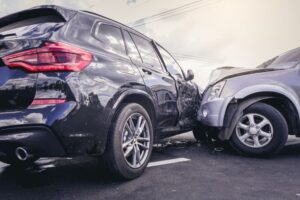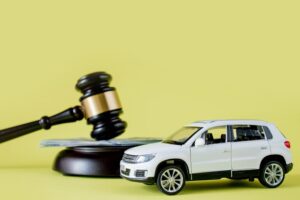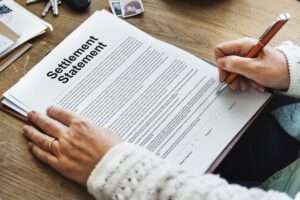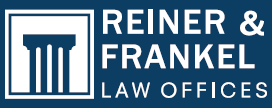Car accidents frequently happen when other drivers fail to watch the road attentively, exhibit road rage, or violate traffic laws. When accident victims suffer injuries, they may be entitled to recover monetary damages for their losses.
In a personal injury claim or lawsuit stemming from a car crash, the injured accident victim has the legal burden of proof. To establish this legal burden, they will need to introduce various pieces of evidence in support of their claim.
A knowledgeable car accident lawyer can gather the appropriate evidence for your case so that you can satisfy your burden of proof and pursue favorable compensation. After filing a claim on your behalf, your lawyer can aggressively engage the insurance company in settlement negotiations or litigate your case to a resolution in the state court system.
Table Of Content
How Do Car Accidents Typically Occur?
 Negligence by other drivers is a common factor contributing to car accidents, resulting in a variety of specific types of collisions on the road. One prevalent form is rear-end collisions, where a driver fails to maintain a safe speed or following distance and strikes the vehicle in front of them. This often occurs when drivers become distracted, tailgate, or misjudge the speeds of vehicles around them.
Negligence by other drivers is a common factor contributing to car accidents, resulting in a variety of specific types of collisions on the road. One prevalent form is rear-end collisions, where a driver fails to maintain a safe speed or following distance and strikes the vehicle in front of them. This often occurs when drivers become distracted, tailgate, or misjudge the speeds of vehicles around them.
Intersection accidents are another common consequence of driver negligence. Drivers who disregard traffic signals, run red lights or fail to yield the right-of-way at intersections frequently cause collisions. These accidents may involve side-impact or T-bone collisions, where one vehicle strikes another from the side, often leading to significant property damage and injuries.
Failure-to-yield accidents commonly result from negligence at intersections, merge lanes, or when entering a roadway. Drivers who neglect to yield to oncoming traffic, pedestrians, or other vehicles may cause accidents that involve broadside collisions or force other drivers to take evasive actions, leading to additional hazards on the road.
Distracted driving also plays a substantial role in various types of accidents. Drivers using mobile phones, texting, or engaging in other distracting activities may divert their attention from the road, increasing the risk of accidents. This negligence can result in collisions ranging from minor fender-benders to more severe accidents with significant injuries.
Speeding is another form of negligence that contributes to accidents of varying severity. Drivers exceeding posted speed limits or driving too fast for road conditions have reduced reaction times, making it more likely for them to lose control of their vehicles. Speed-related accidents can range from single-vehicle crashes to collisions with multiple vehicles on the road.
Lane departure accidents occur when drivers fail to stay within their designated lane. This negligence can lead to sideswipe collisions, where the sides of two vehicles make contact, or run-off-road accidents, where a driver departs the roadway entirely. Lane departure accidents are often the result of distracted or drowsy driving.
If you suffered injuries in one of these types of car accidents, your personal injury lawyer can investigate the accident circumstances and potentially file a claim with the responsible driver’s insurance company on your behalf.
Most Important Evidence in a Car Accident Claim or Lawsuit
In a car accident claim or lawsuit, gathering various types of evidence is crucial to building a strong case and establishing liability. One primary piece of evidence is the accident report that responding police officers generate. This official document provides essential details about the accident, including statements from involved parties, witness information, and observations that the responding officers made. The accident report serves as a foundational element in establishing the facts surrounding the car crash.
Photographic evidence also plays a significant role in documenting the aftermath of a car accident. Clear and detailed photos of the accident scene, vehicle damage, and any visible injuries help to recreate the circumstances surrounding the collision. These photos provide a visual representation of the court, aiding in the understanding of events leading up to the collision.
Medical records are also crucial for proving the extent of injuries sustained in a car accident. Detailed records of medical treatments, diagnostic tests, and physician assessments offer an overview of the physical impact on the individuals involved. This evidence helps to establish the connection between the accident and the claimed injuries.
Eyewitness testimony adds a human perspective to the legal proceedings. Eyewitnesses who observed the car accident can provide firsthand accounts of what transpired. Their statements may corroborate or clarify details presented in other evidence, offering valuable insights into the circumstances surrounding the collision.
Expert witnesses, such as accident reconstruction specialists or medical professionals, can provide specialized knowledge to support the case. Accident reconstruction experts analyze the scene, vehicle damage, and other factors to recreate the sequence of events leading to the accident. Medical experts offer insights into the nature and extent of the accident victim’s injuries, directly relating them to the crash.
Preserving physical evidence from the accident, such as damaged vehicles or roadway debris, is crucial. Experts can inspect this evidence to gain insight into the mechanics of the collision, contributing to a clearer understanding of fault.
Communication records, including emails, text messages, or other correspondence related to the accident, can also be important pieces of evidence. These documents may reveal discussions or admissions that support the accident victim’s case.
A skilled car accident attorney can gather all of the evidence necessary to prove your case, forward all relevant evidence to insurance company adjusters, or, if necessary, present the evidence in court at a legal proceeding.
Recovering Damages in a Car Accident Case
 Car accident victims pursuing a claim or lawsuit may be eligible to recover damages to address the financial, emotional, and physical effects of the occurrence. One critical category is compensation for past and anticipated medical costs. This includes reimbursement for hospital bills, surgeries, medications, rehabilitation, and any other necessary medical treatments related to the victim’s injuries.
Car accident victims pursuing a claim or lawsuit may be eligible to recover damages to address the financial, emotional, and physical effects of the occurrence. One critical category is compensation for past and anticipated medical costs. This includes reimbursement for hospital bills, surgeries, medications, rehabilitation, and any other necessary medical treatments related to the victim’s injuries.
Loss of earning capacity is another significant component. If the injuries hinder the victim’s ability to work or result in a permanent disability (such as paralysis), compensation seeks to account for the potential future income the individual might have earned but for the accident-related limitations.
Pain and suffering damages acknowledge the physical and emotional distress the accident victim experienced due to the car crash. This compensation is necessary to cover the pain, anxiety, and overall reduction in quality of life stemming from the victim’s injuries. Pain and suffering damages aim to address the non-economic effects of the accident on the victim.
Mental distress damages may apply if the accident leads to psychological consequences, such as anxiety, depression, or post-traumatic stress disorder (PTSD). This compensation seeks to address the emotional toll resulting from the traumatic event.
Lost income represents compensation for income that the victim lost during their recovery period (like when they were unable to work during this time). This category aims to lessen the financial effect of the car accident on individuals who suffer debilitating injuries.
Loss of consortium damages extends to spouses or family members. These damages address the loss of companionship, emotional support, and care resulting from the injuries that the victim suffered in the car crash.
Permanent disfigurement or permanent disability damages acknowledge lasting physical changes resulting from the accident. Compensation seeks to address the effects of visible scarring, disfigurement, or long-term disabilities that alter the victim’s life.
Finally, “loss of use” damages may apply if the accident leads to the partial or complete loss of function in a specific body part. Compensation seeks to address the challenges and limitations associated with this loss of use, recognizing the effect on an accident victim’s daily activities.
By understanding these available damages, you can pursue compensation that comprehensively addresses the physical, emotional, and financial repercussions of your collision. An experienced car accident lawyer can highlight the strengths of your case during settlement negotiations and litigation to maximize the monetary award you ultimately recover for your injuries.
How do Settlement Negotiations Proceed During a Car Accident Claim?
 Settlement negotiations with the at-fault driver’s insurance company are a crucial part of a car accident claim. After filing a claim, the injured party and their attorney engage in discussions with the insurance company to reach a fair resolution without going to court.
Settlement negotiations with the at-fault driver’s insurance company are a crucial part of a car accident claim. After filing a claim, the injured party and their attorney engage in discussions with the insurance company to reach a fair resolution without going to court.
The process typically begins with the accident victim’s lawyer submitting a settlement demand letter to the at-fault driver’s insurance carrier. This letter outlines the details of the accident, the injuries sustained, and the financial compensation sought. The demand package also includes copies of related medical records, medical bills, and any other evidence supporting the claim for damages.
Upon receiving this demand letter, the insurance company begins its own investigation. The adjuster will review the provided documentation, assess liability, and consult with their insured (the at-fault driver) to gather additional information. This investigation helps the insurance company evaluate the validity and potential value of the claim.
Once both parties have exchanged information, settlement negotiations can begin. The injured party’s attorney and the insurance adjuster engage in discussions to reach a settlement amount that fairly compensates the victim for their injuries and losses. These negotiations involve back-and-forth communication, where each side presents their case, discusses the strengths and weaknesses of their arguments, and considers potential compromises.
During negotiations, the accident victim’s attorney emphasizes the evidence supporting the claim, such as medical records, accident reports, and witness statements. They may also present legal arguments demonstrating the at-fault driver’s liability and the extent of the victim’s damages. The insurance adjuster, in turn, may raise questions about liability, dispute the severity of injuries, or challenge the value of certain damages.
Throughout the process, both parties work towards finding common ground. Settlement discussions may involve offers, counteroffers, and compromises until the parties reach a final agreement. At that point, the injured party typically signs a release, forfeiting their right to pursue further legal action in exchange for the agreed-upon compensation from the insurance company.
It’s important to note that settlement negotiations can vary in duration and complexity. Some cases may reach a resolution relatively quickly, while others may require more extensive discussions. If a fair settlement cannot be reached, the injured party retains the option to pursue legal action and file a lawsuit against the at-fault driver.
A skilled car accident lawyer can guide you through the settlement negotiation process and handle all communications with insurance company adjusters on your behalf.
Pursuing Litigation after a Car Crash
In a car accident case, individuals have various litigation options to seek resolution for their claims. One option is filing a lawsuit, which involves initiating legal proceedings against the at-fault party in a civil court. Filing a lawsuit is often necessary when settlement negotiations with the insurance company fail to reach a satisfactory outcome. After filing a lawsuit, the legal process officially begins, and both parties engage in formal legal proceedings.
Taking a case to trial is another avenue for resolving a car accident claim. If a lawsuit is filed, the case may progress to trial if the parties cannot reach a settlement agreement. During the trial, the attorneys present evidence, make legal arguments, and call witnesses to the stand before a judge or jury. The judge/jury ultimately decides the outcome, determining liability and the extent of damages to award the car accident victim. While trials provide a formal and structured process for resolving disputes, they can be time-consuming and involve higher legal costs.
Alternative dispute resolution (ADR) methods offer alternatives to traditional court trials. Binding arbitration is one form of ADR where a neutral arbitrator reviews the evidence and makes a binding decision in the case. Mediation is another ADR option, involving a neutral mediator facilitating discussions between the parties to reach a mutually acceptable resolution. Unlike binding arbitration, mediation decisions are not binding unless both parties agree to the terms.
Choosing ADR methods, such as arbitration or mediation, can offer advantages like faster resolution, reduced costs, and a more collaborative process when compared with traditional courtroom trials. However, the outcome depends upon the willingness of both parties to participate in good faith.
Ultimately, the choice between filing a lawsuit, going to trial, or pursuing ADR depends upon the specific circumstances of each case. A knowledgeable car accident lawyer can guide you in determining the most suitable course of action based on the nature of your accident, the extent of your damages, and the likelihood of reaching a fair resolution through negotiation, formal legal proceedings, or ADR.
Speak with a Car Accident Lawyer Near You Today

Russell Reiner, Car Accident Attorney
If you recently suffered injuries in a car crash, a skilled personal injury attorney can be an invaluable help when it comes to gathering evidence and presenting that evidence to an insurance company or court. Your lawyer will zealously advocate for your interests throughout the entire process and work hard to ensure that you recover fair compensation for your losses.
